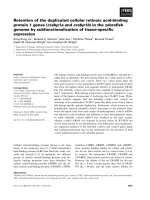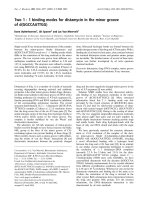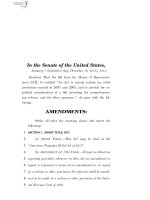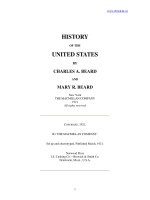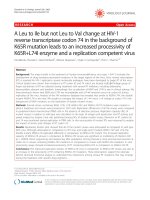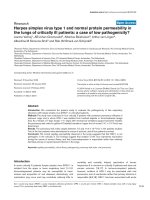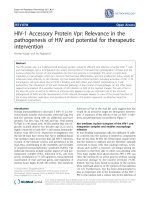Reading b1 TEST 1 5
Bạn đang xem bản rút gọn của tài liệu. Xem và tải ngay bản đầy đủ của tài liệu tại đây (230.69 KB, 61 trang )
TEST 1
PASSAGE 1
It is commonly believed in the United States that school is where people go
to get an education. Nevertheless, it has been said that today children
interrupt their education to go to school. The distinction between
schooling and education implied by this remark is important
Education is much more open-ended and all-inclusive than schooling.
Education knows no bounds. It can take place anywhere, whether in the
shower or on the job, whether in a kitchen or on a tractor. It includes both
the formal learning that takes place in schools and the whole universe of
informal learning. The agents of education can range from a revered
grandparent to the people debating politics on the radio, from a child to a
distinguished scientist. Where as schooling has a certain predictability,
education quite often produces surprises. A chance conversation with a
stranger may lead a person to discover how little is known of other
religions. People are engaged in education from infancy on. Education,
then, is a very broad, inclusive term. It is a lifelong process, a process that
starts long before the start of school, and one that should be an integral
part of one's entire life.
Schooling, on the other hand, is a specific, formalized process, whose
general pattern varies little from one setting to the next. Throughout a
country, children arrive at school at approximately the same time, take
assigned seats, are taught by an adult, use similar textbooks, do homework,
take exams, and so on. The slices of reality that are to be learned, whether
they are the alphabet or an understanding of the workings of government,
have usually been limited by the boundaries of the subject being taught.
For example, high school students know that they are not likely to find out
in their classes the truth about political problems in their communities or
1
what the newest filmmakers are experimenting with. There are definite
conditions surrounding the formalized process of schooling.
1. What is the main idea of the passage?
A. The best school teach a wide variety of subjects.
B. Education and schooling are quite different experiences.
C. Students benefit from schools, which require long hours and homework.
D. The more years students go to school, the better their education is.
2 . What does the author probably mean by using the expression children
interrupt their education to go to school (line 3)?
A. Going to several different schools is educationally beneficial.
B. School vacations interrupt the continuity of the school year.
C. Summer school makes the school year too long.
D. All of life is an education.
3. The word bounds in line 6 is closest in meaning to
A. rules
B. Experience
C. Limits
.
D. exceptions
4. The word chance in line 12 is closest in meaning to
A. unplanned
B. unusual
.
C. lengthy D. lively
5. The word an integral in line 16 is closest in meaning to
A. an equitable
B. a profitable
C. a pleasant
.
D.
an
essential
6. The word they in line 21 refers to
.
A. slices of reality B. similar textbooks
C. boundaries
D. seats
7. The phrase For example, line 23 introduces a sentence that gives
examples of
A. similar textbooks
D. the boundaries of classroom
B. the results of schooling
subjects
C. the workings of a government
8. The passage supports which of the following conclusions?
A. Without formal education, people would remain ignorant.
2
B. Education systems need to be radically reformed
C. Going to school is only part of how people become educated.
D. Education involves many years of professional training.
9. The passage is organized by
A. listing and discussing several educational problems
B. contrasting the meanings of two related words
C. narrating a story about excellent teacher
D. giving examples of different kinds of schools
10. The writer seems to agree that
A.schooling is more important
C.shooling is unlimited and more
than education
informal
B.educațion is not as important as
D. education is more influential
schooling
than schooling
PASSAGE 2
Just as optical fibers (n) [ˈɒp.tɪ.kl ˈfaɪ.bə] (sợi quang) have transformed (v)
[trỉnsˈfɔːrm] (biến đổi) communication (n) [kəˌmjuː.nɪˈkeɪ.ʃən] (thơng tin
liên lạc), they are also revolutionizing (v) [rev.əˈluː.ʃən.aɪzɪŋ] (Cách mạng
hóa) medicin (n) [ˈmed.ɪ.sən] (Y học). These ultra-thin (adj) [ˈʌltrə θɪn]
(Siêu mỏng), flexible (adj) [ˈfleksəbl] (linh hoạt) fibers have opened a
window into the living tissues (n) [ˈtɪʃuːz] (mô) of the body. By inserting
optical fibers through natural (v) [ˈnætʃrəl] (tự nhiên) openings or small
incisions (n) [ɪnˈsɪʒn] (vết rạch) and threading (v) [ˈθredɪŋ] (luồng qua)
them along the body's established (adj) [ɪˈstæblɪʃt] (thiết lập) pathways (n)
[ˈpɑːθweɪ] (đường nhỏ), physicians (n) [fɪˈzɪʃn] (Bác sĩ) can look into the
lungs (n) [lʌŋ] (phổi), intestines (n) [ɪnˈtestɪn](ruột), heart, and other areas
that were formerly inaccessible (adj) [ɪnỉkˈsesəbl] (khơng thể tiếp cận) to
them.
3
Giống như sợi quang học đã biến đổi thông tin liên lạc, chúng cũng đang
cách mạng hóa y học. Những sợi siêu mỏng, linh hoạt này đã mở ra một
cửa sổ vào các mô sống của cơ thể. Bằng cách chèn các sợi quang học qua
các lỗhở tự nhiên hoặc các vết rạch nhỏ và luồn chúng dọc theo các đường
dẫn được thiết lập của cơ thể, các bác sĩ có thể nhìn vào phổi, ruột, tim và
các khu vực khác mà trước đây chúng không thể tiếp cận được.
The basic fiber-optics system is called a fiberscope (n) [ˈfaɪ.bə skəʊp]
(kính sợi quang), which consists of two bundles (n) [ˈbʌndl] (bó) of fibers.
One, the illuminating (adj) [ɪˈluːmɪneɪtɪŋ] (Chiếu sáng) bundle, carries light
to the tissues. It is coupled (v) [ˈkʌpld] (được kết hợp) to a high-intensity
(adj) [haɪɪˈluːmɪneɪtɪŋ] (cường độ cao) light source (n) [sɔːs] (nguồn). Light
enters the cores (n) [kɔː(r)] (lõi) of the high-punity (adj) [haɪ ˈpjuːnəti] (độ
bền cao) silicon(n) [ˈsɪlɪkən] (silicon) glass and travels along the fibers. A
lens (n) [lenz] (thấu kính) at the end of the bundle collects the light and
focuses (v) [fəʊkəsɪz] (hội tụ) it into the other bundle, the imaging bundle.
Each fiber in the bundle transmits [trænzˈmɪt] (truyền) only a tiny (adj)
[ˈtaɪni] (nhỏ xíu) fraction (n) [ˈfrỉkʃn] (Phần nhỏ) of the total (adj) [ˈtəʊtl]
(Toàn bộ) image (n) [ˈɪmɪdʒ] (Hình ảnh). The reconstructed (v) [riːkən
ˈstrʌktɪd] (dựng lại) image can be viewed through an eyepiece (n) [ˈaɪpiːs]
(thị kính) or displayed (v) [dɪˈspleɪ] (hiển thị) on a television screen (n)
[skriːn] (màn hình). During the last five years, improved methods (n)
[ˈmeθəd] (phương pháp) of fabricating (v) [ˈfæbrɪkeɪtɪŋ] (chế tạo) optical
fibers have led to a reduction (n) [rɪˈdʌkʃn] (giảm) in fiberscope
diameter(n) [daɪˈæmɪtə] (đường kính) and an increase in the number of
fibers, which in tum (n) [tʌm] (dạ dày) has increased resolution (n) [rezə
ˈluːʃn] (độ phân giải).
Hệ thống sợi quang cơ bản được gọi là kính sợi, bao gồm hai bó sợi. Một,
bó chiếu sáng, mang ánh sáng đến các mơ. Nó được kết hợp với một nguồn
sáng cường độ cao. Ánh sáng đi vào lõi của thủy tinh silicon có độ bền cao
4
và truyền dọc theo các sợi. Một thấu kính ở cuối gói thu thập ánh sáng và
hội tụ ánh sáng vào gói cịn lại, gói hình ảnh. Mỗi sợi trong bó chỉ truyền
một phần nhỏ trong tổng số hình ảnh. Hình ảnh được dựng lại có thể được
xem qua thị kính hoặc hiển thị trên màn hình tivi. Trong năm năm qua, các
phương pháp chế tạo sợi quang học được cải tiến đã dẫn đến việc giảm
đường kính ống soi và tăng số lượng sợi, điều này làm tăng độ phân giải
trong dạ dày.
Optical fibers can also be used to deliver (v) [dɪˈlɪvə] (phóng ra) laser light.
By use of laser beams (n) [biːm] (chùm), physicians can perform (v)[pə
ˈfɔːm] (tiến hành) surgery (n) [ˈsɜːdʒəri] (phẫu thuật) inside the body,
sometimes eliminating (v) [ɪˈlɪmɪneɪtɪŋ] (loại bỏ) the need for invasive (adj)
[ɪnˈveɪsɪv] (xâm lấn) procedures (n) [prəˈsiːdʒə] (thủ thuật) in which
healthy tissue must be cut through to reach the site of discase. Many of
these procedures do not require (v) [rɪˈkwaɪə(r)] (cần đến) anesthesia (n)
[ˌænəsˈθiːziə] (gây mê) and can be performed in a physician's office. These
techniques (n) [tekˈniːk] (kĩ thuật) have reduced the risk (n) [rɪsk] (rủi ro)
and the cost of medical care.
Sợi quang học cũng có thể được sử dụng để phóng ra ánh sáng laser. Bằng
cách sử dụng chùm tia laser, bác sĩ có thể tiến hành phẫu thuật bên trong cơ
thể, đơi khi loại bỏ sự cần thiết của các thủ thuật xâm lấn, trong đó các mơ
khỏe mạnh phải được cắt qua để tiếp cận vị trí bị thối hóa. Nhiều thủ thuật
trong số này khơng cần gây mê và có thể được thực hiện tại phòng khám
của bác sĩ. Những kỹ thuật này đã làm giảm rủi ro và chi phí chăm sóc y tế.
WORDS PRONOUNCE MEANING
optical fibers (n) /ˈɒp.tɪ.kl ˈfaɪ.bə/ Sợi quang
transformed (v) /trænsˈfɔːrm/ Biến đổi
Revolutionizing (v) /rev.əˈluː.ʃən.aɪzɪŋ/ Cách mạng hóa
Medicine (n) /ˈmed.ɪ.sən/ Y học
ultra-thin (adj) ˈʌltrə θɪn Siêu mỏng
5
Flexible (adj) ˈfleksəbl Linh hoạt
Tissue (n) ˈtɪʃuː Mô (tế bào)
Incisions (n) ɪnˈsɪʒn Vết rạch
Threading (v) ˈθredɪŋ Luồng qua
Established (adj) ɪˈstæblɪʃt Thiết lập
Pathway (n) ˈpɑːθweɪ đường nhỏ
Physician (n) fɪˈzɪʃn Bác sĩ
Lung (n) lʌŋ Phổi
Intestines (n) ɪnˈtestɪn Ruột
Inaccessible (adj) ɪnỉkˈsesəbl Khơng thể tiếp cận
Fiberscope (n) ˈfaɪ.bə skəʊp Kính sợi quang
Bundle (n) ˈbʌndl bó
Illuminating (adj) ɪˈluːmɪneɪtɪŋ Chiếu sáng
coupled ˈkʌpld Được kết hợp
high-intensity (adj) [haɪ ɪˈluːmɪneɪtɪŋ] Cường độ cao
Source (n) sɔːs Nguồn
Core (n) kɔː(r) lõi
high-punity (adj) haɪ ˈpjuːnəti Độ bền cao
Silicon (n) ˈsɪlɪkən silicon
lens (n) lenz Thấu kính
Focuses (v) ˈfəʊkəsɪz Hội tụ
transmit (v) trỉnzˈmɪt Truyền
tiny (adj) ˈtaɪni Nhỏ, nhỏ xíu xìu xiu
Fraction (n) ˈfrỉkʃn Phần nhỏ
total (adj) ˈtəʊtl Toàn bộ
Reconstruct (v) riːkənˈstrʌkt Dựng lại
Image (n) ˈɪmɪdʒ Hình ảnh
Eyepiece (n) ˈaɪpiːs Thị kính, kính mắt
Display (v) dɪˈspleɪ Hiển thị
6
Screen (n) skriːn Màn hình
Improve (v) ɪmˈpruːv Cải tiến
Method (n) ˈmeθəd Phương pháp
Fabricating (v) ˈfæbrɪkeɪtɪŋ Chế tạo
Reduction (n) rɪˈdʌkʃn Sự giảm bớt
Diameter (n) daɪˈỉmɪtə Đường kính
Tum (n) tʌm Dạ dày
Resolution (n) ˌrezəˈluːʃn Độ phân giải
Deliver (v) dɪˈlɪvə Phóng ra
Beam (n) biːm Tia, chùm
Perform (v) pəˈfɔːm Tiến hành
Surgery (n) ˈsɜːdʒəri Phẫu thuật
Eliminate (v) ɪˈlɪmɪneɪt Loại bỏ
Invasive (adj) ɪnˈveɪsɪv Xâm lấn
Procedure (n) prəˈsiːdʒə Thủ thuật
Anaesthesia (n) ˌænəsˈθiːziə Gây mê
technique (n) tekˈniːk Kỹ thuật
Risk (n) rɪsk Rủi ro
11. What is the main subject of the passage?
A. The role of optical fibers in medicine B. New surgical techniques
C. The invention of optical fibers D. A revolution in communication
12. In line 2, the author uses the expression have opened a window to
indicate
that the use of optical fibers _____
A. has been unknown to the general public quite recently
B. sometimes requires a surgical incision
C. allows doctors to see inside the body without major surgery
D. has enabled scientists to make amazing discoveries.
7
13. Which of the following is closest in meaning to the word formerly in
line 6?
A. previously
B. usually
C. theoretically
D. completely
14. The word them in line 6 refers to_____
A. physicians
B. optical fibers
C. pathways
D. other areas of the body
15. According to the passage, what is the purpose of the illuminating
bundle in
the fiberscope?
A. To reconstruct images
B. To perform surgery inside the body
C. To carry light into the body
D. To collect and focus light he body
16. Which of the following is closest in meaning to the word cores in line
9?
A. clusters B. lines C. tips D. centers
17. According to the passage, how do the fiberscopes used today differ
from those
used five years ago?
A. They are larger in diameter. B. They use brighter lights.
C. They are longer. D. They contain more fibers.
18. The word resolution in line 16 is closest in meaning to which of the
following?
A. efficiency B. sharpness C. inconvenience D. strength
8
19. Which of the following is not mentioned by the author as one of the
advantages of laser surgery techiques?
A. They are safer than conventional surgery
B. They are relatively easy to teach to physicians
C. They can be performed in a physician's office
D. They can often be performed without anethesia
20. Where in the passage does the author provide a basic description of a
fiberscope?
A. Line 1-3 B. Line 11-13 C. Line 7-9 D. Line 15
PASSAGE 3
Ever wondered what it feels like to have a different job? Here, four people
with very different careers (/ kəˈrɪə (r) /, nghề nghiệp) reveal(/ rɪˈviːl /, tiết
lộ) the trade secrets of their working day.
Luc:
My day typically starts with a business person going to the airport, and
nearly always ends with a drunk. I don’t mind (/ maɪnd /, chú ý) drunk
people. Sometimes I think they're the better version of themselves (/ ðəm
ˈselvz /): more relaxed, happier, honest. Only once have I feared (/ fɪə (r) /,
nỗi sợ) for my life. A guy ran out at a traffic light and so I sped (/ sped /,
tăng tốc)up before his brother could run, too. He seemed embarrassed(/ ɪm
ˈbærəst /, lúng túng) and made me drop him at a car park. When we arrived,
the first guy was waiting with a boulder(/ ˈBəʊldə (r) /, tảng đá), which
went through the windscreen(/ ˈWɪndskriːn /, kính ơ tơ), narrowly(/
ˈNỉrəʊli /, trong gang tất, st nữa) ( missing my head. But the worst
people are the ones who call me “Driver!”
Harry:
I not only provide appearance(/ əˈpɪərəns /) for my client(/ ˈKlaɪənt /, khách
hàng), I also do damage control(/ ˈDỉmɪdʒ / kənˈtrəʊl /, kiểm sốt thiệt
9
hại) /. We've had clients involved in lawsuits(/ ˈLɔːsuːt / kiện cáo),
divorces(/ dɪˈvɔːs /, ly hôn) or drugs(/ drʌɡ /, mai túy). One mistakenly(/ mɪ
ˈsteɪkənli /, nhầm lẫn) took a gun to an airport. On the red carpet(/ ˌRed
ˈkɑːpɪt /, thảm đỏ) - at the Academy Awards or the Golden Globes - I'm the
person making my client look good. The other day at an Oprah Winfrey
event, the carpet wasn't put down properly and my clients almost went
flying - I had to catch them. They can make some strange(/ streɪndʒ /, lạ
lùng) requests, too. At a black-tie gala at the White House, two clients
hated the dinner and insisted(/ ɪnˈsɪst /, khăng khăng) that we circle(/ ˈSɜːkl
/, vòng quanh) around Washington DC to find a KFC open at la.m. I had to
go in wearing a gown(/ ɡaʊn /, áo choàng) and order so they could eat it in
the
Jennifer:
I could teach you to do a basic(/ ˈBeɪsɪk /, cơ bản) brain operation
(/
ˌⱰpəˈreɪʃn /, hoạt động) in two weeks. But what takes time and experience
(/ ɪkˈspɪəriəns /, kinh nghiệm) is doing it without wrecking(/ Rekɪŋ/, phá
hủy) the brain of the patients(/ ˈPeɪʃnt /, bệnh nhân) – earning your
limitations(/ ˌLɪmɪˈteɪʃn /sự hạn chế, giới hạn) takes years. I ended up
working as a pediatric(/ ˌPiːdiˈætrɪk /, nhi khoa) neurosurgeon(/
ˈNjʊərəʊsɜːdʒən/, giải phẫu thần kinh) because children make better
recoveries(/ rɪˈkʌvəri /, phục hồi) from brain damage(/ ˈDæmɪdʒ /, chấn
thương) than adults. So it's more rewarding(/ rɪˈwɔːdɪŋ /,xứng đáng) in
terms of outcome(/ ˈAʊtkʌm /, kết quả) and I find their resilience(/ rɪ
ˈzɪliəns /, khả năng phục hồi) really inspiring(/ ɪnˈspaɪərɪŋ /, cảm hứng). It's
taken me a decade (/ ˈDekeɪd /, thập kỉ)
to become comfortable
discussing(/ dɪˈskʌs /, bàn luận) an operation(ca phẫu thuật) with children,
but they have to be able to ask questions. You have to show them respect.
Sometimes their perspective(/ pəˈspektɪv/,quan điểm, góc nhìn) is funny;
most teenage girls just want to know how much hair you'll shave off.
10
I don't get upset(/ ˌɅpˈset /, buồn phiền, khó chịu) by my job. These
children are dying when they come in and
I do whatever I can to make them better.
Solange:
When you become a judge(/ dʒʌdʒ /, thẩm phán) after years of being a
barrister(/ ˈBærɪstə (r) /, luật sư) and trying to make points(/ pɔɪnt /,quan
điểm) that win cases, you have to remember that a huge part(/ hjuːdʒ / / pɑːt
/, một phần lớn) of what you do is listening - to advocates (/ ˈỈdvəkət /,
biện hộ), to witnesses(/ ˈWɪtnəs /, nhân chứng), to defendants(/ dɪˈfendənt /,
nhân chứng). Behind closed doors most judges, even very experienced(/ ɪk
ˈspɪəriənst /, có kinh nghiệm) ones, are much more anxious(/ ˈỈŋkʃəs /, lo
lắng) about their work than most people might think. We agonise
(/
ˈỈɡənaɪz /, dằn vặt) over what we do and the decisions (/ dɪˈsɪʒn /, phán
quyết) we have to make. It would be bizarre(/ bɪˈzɑː (r) /, kỳ lạ) to say that
as a judge, we learn to be less judgmental(/ dʒʌdʒˈmentl /, phán xét). But as
you see the complex(/ ˈKɒmpleks /,phức tạp) and difficult(/ ˈDɪfɪkəlt /, khó
khăn) lives of the people who end up in front of you, you realise(/
ˈRiːəlaɪz /, nhận ra) that your job is not so much to judge them as to
ensure(/ ɪnˈʃʊə (r) /, chắc chắn) that everyone receives(/ rɪˈsiːv /, nhận)
justice(/ ˈDʒʌstɪs /, sự công bằng)
21. In the first paragraph, what best paraphrases the sentence My day
typically starts with a business person going to the airport, and nearly
always ends with a drunk?
A. Normally, I will take a business person and a drunk at the airport
B. Normally, I will go to the airport in the morning and come back with a
drunk.
C. Normally, my first passenger will be a businessman and my last one a
drunk.
11
D. Normally, I will drive a businessman to the airport and come back
almost drunk.
22. What does Harry probably do for a living?
A. A tour guide
B. An agent( quản lý)
C. A lawyer
D. A
drives
23. The word circle in line 20 could be best replaced by
A. look
B. drive
C. walk
D. ride
24. In line 26, what does Jennifer mean when she says, Learning your
limitations takes years? Đạt được những hạn chế
It takes a person a long time to
A. perform even a basic operation.
C.
control
his
weakness
in
(thực hiện hoạt động cơ bản.
operation (kiểm soát điểm yếu của
B. understand what he cannot
anh ta trong hoạt động)
help.
D. be able to perform a brain
surgery.(có thể thực hiện một cuộc
phẫu thuật não)
25. The word their in line 29 refers to
A. patients’
B. neurosurgeons’
C. children's
D.
adults’
26. The word perspective in line 32 is closest in meaning to
A. prospective- tương lai B. Worry – lo lắng C. View – tầm nhìn
D.
question 27. According to the passage, whose job involves in a large part listening to
others?
A. Jennifer's
B. Harry's
C. Luc’s
D. Solange’s
28. According to the passage, who is likely to meet different types of
people every day?
A. Solange B. Harry
C. Jennifer D. Luc
12
29. The word ones in line 40 refers to
A. barristers
B. judges
C. advocates
D.
defendants
30. What is the purpose of this passage?
A. to discuss the advantages and disadvantages of these jobs (thảo luận về
những thuận lợi và khó khăn của những cơng việc)
B. to report what different people do and think about their jobs(báo cáo
những gì người khác làm và nghĩ về cơng việc của họ)
C. to raise awareness of the importance of different jobs( nâng cao nhận
thức về tầm quan trọng của những công việc khác nhau)
D. to inform people of what to expect in those jobs ( thông báo cho mọi
người về những gì mong đợi trong cơng việc đó)
PASSAGE 4
A.
Supermarket shopping with children, one mother says, is absolute
murder: “They want everything they see. If it's not the latest sugar-coated
breakfast cereal, it's a Disney video or a comic. Usually all three. I can't
afford all this stuff and, anyway, if I agree to their demands I feel I've been
persuaded against my better judgment and I feel guilty about buying
andfeeding them rubbish. Yet I hate myself for saying no all the time, and I
get cross and defensive in anticipation as we leave home. I do my best to
avoid taking them shopping but then I worry that I'm not allowing them to
haye the experience they need in order to make their own choices. I can't
win.
B.
Research has found that children taken on a supermarkettrip make a
purchase request every two minutes. More than $150 million a year is now
spent on advertising directly to children, most of it on television. That
figure is likely to increase and it is in the supermarket aisles that the
investment is most likely to be successful. For children, the reasons behind
13
their parents’ decisions about what they can and cannot afford are often
unclear, and arguments about how bad sugar is for your teeth are
unconvincing when compared with the attractive and emotionally
persuasive advertising campaigns.
C.
According to Susan Dibb of the National Food Alliance, 'Most
parents are concerned about what they give their children to eat and have
ideas about what food is healthy - although those ideas are not always
accurate. Obviously, such a dialogue between parents and children is a
good thing, because if the only information children are getting about
products is from TV advertising, they are getting a very one-sided view.
Parents resent the fact that they are competing with the advertising industry
and are forced into the position of repeatedly disappointing their children.'
The Independent Television Commission, which regulates TV advertising,
prohibits advertisers from telling children to ask their parents to buy
products. But, as Dibb points out, "The whole purpose of advertising is to
persuade the viewer to buy something. So even if they cannot say, "Tell
your mum to buy this product," the intended effect is precisely that.’
D.
A major source of stress for some parents shopping with children is
the mental energy required to decide which demands should be agreed to
and which should bc refused. One mother, says she has patience when it
comes todiscussing food with her children, but she still feels unhappy about
the way she manages their shopping demands: 'My son does pay attention
to advertisements but he is critical of them. We talk a lot about different
products and spend time looking at labels. I've talked about it so much that
I've brainwashed him into thinking all adverts are rubbish. We have very
little conflict in the supermarket now because the children don't ask for
things I won't want to buy.
E.
Parents also admit they are inconsistent, even hypocritical, in their
responses to their children's purchasing requests. Mike, father of a son of
14
seven and a daughter of three, says, 'We refuse to buy him the sweets he
wants on the grounds that it's bad for him while we are busy loading the
trolley with double cream and chocolate for ourselves. It's enjoyable to buy
nice things, and it's quite reasonable that children should want to share that,
I suppose. But I stil find myself being irritated by their demands. It partly
depends on how I feel. If I'm feeling generous and things are going well in
my life, I'm more likely to say yes, It's hard to be consistent.’
31. What makes the woman of the first passage feel terrible when shopping
with her kids?
A. She cannot afford all the stuff for her children.
B. The children demand things all the time, including something bad and
not good for them.
C. When the children want something not good for them, she is tired of
saying 'no'
but is to blame, for agreeing to buy.
D. She cannot have freedom to buy what she wants.
32. Why don't she just leave them home and go shopping by herself?
A. She is afraid of her children not having chances of deciding themselves.
B. She is afraid of their safety if she leaves them alone at home.
C. She wants her children to decide whether go or not.
D. She feels lonely and uncertain if she goes by herself.
33. What makes the children want to buy stuff every two minutes ?
A. an easy-catching view
C. B & C are correct.
B. fascinating advertisement
D. None is correct.
34. What is the-main-idea-of the text?
A. Supermarket shouldn't let colorful stuff in the main aisles.
B. There should only be appropriate programs on television for children.
C. Parents shouldn’t bring their children to the supermarket.
15
D. Parents should give more persuasive reasons to explain for their
children.
35. Which paragraph of the article mentions 'the fact that children do not
understand why their parents refuse their demands?
A. Paragraph
B
C. Paragraph D
B. Paragraph C
D. Paragraph E
36. Which paragraph of the article mentions 'a parent who feels annoyed
even before the children ask for anything'?
A. Paragraph A
C. Paragraph C
B. Paragraph B
D. Paragraph D
37. Which paragraph of the article mentions 'a family who rarely argue
while shopping"?
A. Paragraph A
C. Paragraph C
B. Paragraph B
D. Paragraph D
38. Which paragraph of the article mentions 'a parent who has different
rules for themselves and their children"?
A. Paragraph B
C. Paragraph A
B. Paragraph C
D. Paragraph E
39. Which paragraph of the article mentions ‘someone who feels children
ought to find out for themselves how to make decisions about what to
buy’?
A. Paragraph A
C. Paragraph C
B. Paragraph B
D. Paragraph D
40. Which paragraph of the article mentions "the regularity of children's
demands"?
A. Paragraph A
C. Paragraph C
B. Paragraph B
D. Paragraph D
TEST 2
PASSAGE 1
16
It is estimated that over 99 percent of all species that ever existed have
become extinct. What causes extinction? When a species is no longer
adapted to a change environment, it may perish. The exact causes of a
species' death vary from situation to situation. Rapid ecological change
may render an environment hostile to a species. For example, temperatures
may change anda species may not adapt. Food resources may be affected
by environmental changes, which will then cause problems for a species
requiring these resources. Other species may become better adapted to an
environment, resulting in competition and ultimately, in the death of a
species.
Fossil record reveals that extinction has occurred throughout the history of
Earth. Recent analyses have also revealed that on some occasions many
species became extinct at the same time - a mass extinction. One of the best
- known examples of mass extinction occurred 65 million years ago with
the demise or dinosaurs and many other forms of life. Perhaps the largest
mass extinction was the one that occurred 225 million years ago when
approximately 95 percent of all species died. Mass extinctions can be
caused by a relatively rapid change in the environment and can be
worsened by the close interrelationship of many species. If, for example,
something were to happen to destroy much of the plankton in the oceans,
then the oxygen content of Earth would drop, affection even organisms not
living in the oceans. Such a change would probably lead to a mass
extinction.
One interesting, and controversial finding is that extinctions during the past
250 million years have tended to be more intense every 26 million years.
The periodic extinction might be due to intersection of the earth's orbit with
a cloud of comets, but this theory is purely speculative. Some researchers
have also speculated that extinction may often be random. That is, certain
species may be eliminated and others may survive for no particular reason.
17
A species’ssurvival may have nothing to do with its ability or inability to
adapt. If so, some of revolutionary history may reflect a sequmce of
essentially random events.
1. The underlined word ultimately closest in meaning to
A. exceptionally
B. Unfortunately C. Eventually
D. dramatically
2. What does the author say in paragraph 1 regarding most species in
Earth's history?
A. They have been able to adapt to ecological changes
B. They have caused rapid change in the environment
C. They have remained basically unchanged from their original forms.
D. They are no longer in existence
3. Which of the following is NOT mentioned in paragraph 1 as reulting
from rapid ecological change?
A. Availability of food resources
C. Temperature changes
B. Introduction of new species
D. Competition among species
4. The word demise is clogest in meang to
A. help
B. death
C. Recovery
D. change
5. Why is plankton mentioned in the second paragraph?
A. To emphasize the importance of food resources in preventing mass
extinction
B. To illustrate a comparison between organisms that live on the land and
those that live in the ocean
C. To point out that certain species could never become extinct
D. To demonstrate the interdepemdence of different species
6. According to paragraph 2, evidence from fossils suggests that
A. there has been only one mass extinction in earth's history
B. extinction of species has occurred from time to time throughout
earth's history
C. extinctions on earth have generally been massive
18
D. dinosaurs became extinct much earlier than scientists originally believed
7. The underlined word finding is closest in meaning to
A. published information
C. scientific discovery
B. research method
D. on going experiment
8. Which of the following can be inferred from the theory of periodic
extinction mentioned in paragraph 3?
A. The theory is no longer seriously considered.
B. Most scientists believe the theory to be accurate.
C. Many scientists could be expected to disagree with it.
D. Evidence to support the theory has recently been found.
9. In paragraph 3, the author makes which of the following statements
about a specie's survival?
A. It is associated with astronomical condition.
B. It may depend on chance events.
C. It does not vary greatly from species to species
D. It reflects the interrelationship of many species.
10. According to the passage, it is believed that the largest extinction of the
A. 65 million years ago
C. 225 million years ago
B. 250 million years ago
D. 26 million years ago
PASAGE 2
Clipper ships were the swiftest sailing ships that were put to sea and the
most beautiful. These ships had their days of glory in the 1840s and 1850s.
The first were built in Baltimore, but most were constructed in the
shipyards of New England. It was Chinese tea that brought them into
existence. Tea loses it flavor quickly when stored in the hold of a vessel,
and merchants were willing to pay top prices for fast delivery. American
ship-builders designed clippers to fill this need. Then came the California
Gold Rush of 1849, when clippers took gold seekers from the East Coast to
the West by way of Cape Horn.
19
Clippers were built for speed, and considerations of large carrying capacity
and economical operation were sacrificed for this purpose. They had long,
slender hull with sharp bows. Their three slanted masts carried a huge
cloud of canvas sail, including topgallants and royal sails, and sometimes
skysails and moonrakers, to capture the power of the winds. They required
a hard- driving captain and a large, experienced crew.
Many records were set by clippers. Sovereign of the Seas made it from San
Francisco to New York in eighty-two days. Flying Cloud did 374 miles in
one day. Lightning traveled from New York to Liverpool in thirteen days,
and Ino made it from New York to Singapore in eight-six days.
Some 500 clippers were built in American shipyards. British yards turned
out some twenty-seven tea clippers, as the British ships were called. Unlike
the wooden American ships, British clippers were "composites" with iron
frames and wooden planking. The most famous tea clipper was the Cutty
Sark.
By 1860, the age of the clippers was fading. Gold diggings in California
were nearly exhausted. American investors found railroad building more
profitable than clippers. Most importantly, there was a technological
innovation that doomed the clipper, and in fact, the entire age of sail: the
development of the steamship.
11. What is the author's main purpose of the writing?
A. To provide a brief history of
C. To discuss nineteenth-century
clipper ships
shipbuilding techniques
B. To describe the tea trade in the
D. To contrast clipper ships and
1840s
steamships
12. Which of the following is closet in meaning to the word swiftest in line
1?
A. fastest
B. most expensive
C. largest
20
D. best armed
13. According to the passage, where were the majority of clipper ships
built?
A. New England
B. California
C. Baltimore
D.
Great Britain
14. In line 5, the word vessel could best be replaced by which of the
following?
A. merchant
B. container
C. cargo
D. ship
15. According to the passage, how did the California Gold Rush affect
clipper ships?
A. People who wanted to participate in the Gold rush became passengers
on clipper ships
B. It stimulated the demand for tea on the West Coast
C. It encouraged the development of railroads, which competed direetly
with clipper ships
D. The newly discovered gold was used to finance the construction of new
ships
16. According to the passage, which of the following considerations was of
the most importance to the owners of clipper ships?
A. Small crews
C. Increased cargo capacity
B. Reduced operating costs
D. Maximum speed
17. Which of the following is closest in meaning to the word slanted in line
12?
A. Tilted
B. Towering
C. Strengthened
D. Slender
18. What can be inferred from the passage about skysails and moonrakers?
A. They were never used on clipper ships.
B. Skysails were the highest sails on the mast, and moonrakers were the
lowest.
C. They were not always used on clipper ships.
D. They were much larger than royal sails and topgallants.
21
19. All of the following are given in the passage as reasons for the decline
of clipper ships EXCEPT
A. the development of steamships
D. the end of the California Gold
B. investment in railroad
Rush
C. competition with British tea
clippers
20. In the next paragraph, the author will most likely discuss
A. the relationship between speed
C. the beginnings of the age of
and ship design
steam
B. further developments in sailing
D. railroad travel in the United
ships
States
PASSAGE 3
Spring is the season when newly minted college graduates flock to New
York City to start their careers. They begin the search for their dream
apartment, brokers say, with the same single-minded determination that
earned them their degrees and landed them their jobs in the first place. But
that determination only goes so far when it comes to Manhattan real estate.
[A]
"Almost every single person l've worked with thinks there's a golden
nugget of an apartment "waiting right for them," said Paul Hunt, an agent at
Citi Habitats who specializes in rentals. "They all want to be in the Village,
and they all want the 'Sex and the City' apartment."
The first shock for a first-time renter will probably be the prices. Consider
that the average mmonthly rent for a one-bedroom in the Village is more
than $3,100 and that the average for a studio is over $2,200, Or that the
average rent for a one-bedroom in a doorman building anywhere in
Manhattan is close to $3,500. [B]
22
Mr. Hunt said that when he shows prospective renters what their budget
really can buy; they are sometimes so appalled that "they think I'm trying to
fool them or sofmething, and they run away and I don't hear from them
again."
Alternatively, the renter checks his or her expectations and grudgingly
decides to raise the price limit, or look in other neighborhoods or get a
roommate. "When expectations are very high, the process can be very
frustrating," Mr. Hunt said.
The thousands of new graduates who will be driving the engine of the city's
rental market from now until September will quickly leam that renting in
New York is not like renting anywhere else. [C]
The second shock is likely to be how small a Manhattan apartment can be.
It is not uncommon in New York, for example, to shop for a junior onebedroom only to find out it is really a studio that already has or can have a
wall put up to create a bedroom.
[D] To start with, landlords want only tenants who earn at least 40 times the
monthly rent, which means an $80,000 annual salary for a $2,000
apartment. According to census data, more than 25,000 graduates aged 22
to 28 moved to the city in 2006, and their median salery was about
$35,600.
Those who don't make 40 times their'monthly fent need a guarantor,
usually a parent, who must make at least 80 times the monthly rent. In
addition to a security deposit some landlords also want the first and last
month's rent. Tack on a broker's fee and a prospective renter for that $2,000
apartment is out of pocket nearly $10,000 just to get the keys to the place.
21. Which of the following would be the best title for this article?
A. Best Guide to Finding an Apartment in New York City
B. New York City - Haven for First-time Renters
C. Surprises Await First-time Renters in New York City
23
D. Sure You Can Afford it in New York City?
22. On average, how much do tenants have to pay for a studio in New York
City?
A. About $2,000
C. More than $3,100
B. More than $2,000
D. Less than $3,500
23. Which of the following words can best replace the word prospective in
line 15?
A. Apparent
B. Prosperous
C. Potential
D.
Upcoming
24. Which of the following is NOT listed by Mr. Hunt as a reaction of
prospective renters when he informs them of the prices?
A. They think the broker is meaning to deceive them.
B. They decide to move to another city.
C. They decide to look for a place in a different neighborhood.
D. They find someone to share the accommodation with.
25. According to Mr. Hunt, what would make the process of finding an
apartment challenging?
A. Renters do not trust the brokers
B. Renters over expectabout places they can rent.
C. Landlords expect tenants to have secured income
D. Renters want to bargain with landlords.
26. Which of the following would best describe the attitude of renters who
decide to raise their price limit after being informed of the price?
A. Willing
B. Hopeful
C. Reluctant
D.
Frustrated
27. In which space (marked [A], [B], [C] and [D] in the passage) will the
following sentence fit? Aside from the realities of price and space, the
requirements set by New York landlords are also bound to help turn a
bright-eyed first-time renter's outlook grim.
24
A. A
B. B
C. C
D. D
28. Why did the writer mention the income of college graduates in 2006?
A. To demonstrate that graduates can earn a decent salary if they work in
New York City
B. To indicate that less than 50% of the surveyed graduates could afford
apartments in New York City
C. To suggest that New York City is not a place for graduates
D. To prove that to guarantee a place in New York City is financially
out of reach for an average graduate
29. What does the word Those in line 28 refer to?
A. Landlords
B. Graduates
C. Guarantors
D. Parents
30. Which of the following sentences would best complete the last
paragraph?
A. On top of that, every owner also has their own requirements, so just
because you qualified here doesn't mean you'Il qualify there.
B. So you had better accept that you'll never have what you want no matter
how hard you work.
C. So the key to finding that first apartment is to learn as much as possible
about the market before arriving in the city and to keep an open mind.
D. You have to be flexible and you have to come to the city armed with
information and financial paperwork.
PASSAGE 4
It's often said that we learn things at the wrong time. University students
frequently do the minimum of work because they're crazy about a good
social life instead. Children often scream before their piano practice
because it's so boring. They have to be given gold stars and medals to be
persuaded to swim, or have to be bribed to take exams. But the story is
different when you're older.
25

